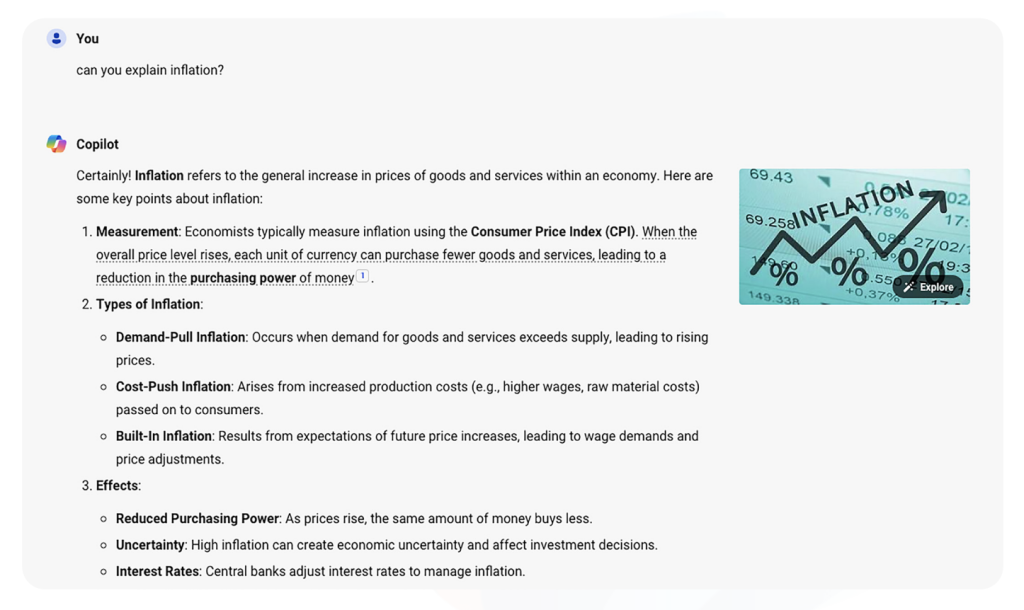We have all heard the phrase time is money; if that is true, then Microsoft’s AI assistant, Copilot, has the potential to increase your bank balance significantly.
Most businesses will find that this time saving is accomplished in three ways: First, by automating repetitive tasks, like replying to emails, writing press releases, or creating social media posts. Second, by helping employees to brainstorm more quickly and easily, coming up with better ideas. Third, by generating reams of high-quality content much more quickly than an unassisted human could, like blog posts, white papers, and unique visual assets. In this Ultimate Guide, you’ll learn everything you need to know about Copilot:
• What is Microsoft Copilot?
• Where can I get Microsoft Copilot?
• What are the benefits of using Microsoft Copilot?
• Four ways Copilot can make an impact in your business right now
• The significant ROI of Business Central
• Four ways Microsoft ensures data security in Copilot, and
• What does the future hold for Microsoft Copilot?
However, before we tackle these subjects, let’s quickly go over where Copilot came from, and how AI assistants like it are revolutionising industries left, right and centre…
Rise of the machines
OpenAI changed the game when it went public with ChatGPT about eighteen months ago, making it possible to produce thousands of words on almost any subject in just a few minutes. Competitors soon appeared to capitalise on different things: Sudowrite, for instance, is designed for fiction writers, while Perplexity focuses on research. Copilot is Microsoft’s horse in the AI race, and for our purposes here, it’s notable for two reasons: First, Microsoft is unquestionably the company you should be listening to when it comes to new technology. It’s the world’s biggest tech company, and it’s a market leader in enterprise software; and second, the company has developed Copilot with businesses just like yours in mind. Creative is a long-established Microsoft Gold Partner, which means we’re the perfect people to walk you through this revolutionary new software tool; but first, you need a clear picture of what it is.

What is Microsoft Copilot?
Like ChatGPT and other AI assistants, Microsoft Copilot is a chatbot. A chatbot is just a “bot” (i.e., computer programme – not a real person) that “chats” (i.e., produces natural language responses when prompted by a user). Chatbots have existed for years, but what makes this latest iteration of them something special is the fundamental architecture behind them: Large Language Models (LLMs). You can imagine an LLM as an enormous and very complicated autocorrect machine that the chatbot is accessing to create something that reads like human-written text. In very simplistic terms, it works like this: An LLM is an AI that creates semantic maps of all the words in a natural language (i.e. a human language, like English) based on how closely they are related to one another – and it does this along hundreds of different parameters. “Happy” and “sad” might be right next to each other on one parameter, as emotional states, but far apart from each other on another parameter, as antonyms or opposites. These maps have been built by letting the LLM “read” hundreds of billions of words of human generated text (on internet forums, from novels and magazines, etc.). LLMs are always picking the word most-likely to come next and writing it down. However, they’re hugely complicated, and weight the probability of each word differently depending on which word comes before the word they’re following on from, and the word before that, and before that, for as long as their memory allows. The result is unique, natural language, text that reads as though it has been written by a human.
Copilot, or Copilots?
Microsoft Copilot is a very special LLM chatbot that’s been built to service business needs at any scale. In addition to the fact that it’s built on the latest and most powerful LLM around, Copilot comes with three enormous positives that should make it an easy choice for businesses on the lookout for a chatbot: First, it has been built to integrate with Microsoft’s exceptional suite of enterprise tools. Second, it’s secure and comes with reliable data protection options. Third, you can customise Copilot using plugins – additional software that “plugs in” to Copilot and lets it perform specific tasks (for example, retrieving the latest news every morning). Copilot comes in three tiers: free, pro, and the enterprise-facing Copilot for Microsoft 365. Here is how they compare:

You’ll notice that most of the added value in Copilot Pro and Copilot for Microsoft 365 comes in the form of better versions of what Copilot is already doing (i.e.: priority access to the GPT-4 Turbo LLM) or integrations with existing software you probably already know about (like Microsoft 365). Partly for this reason, and partly because many businesses will want to try the free tier before paying for an upgraded service, this guide will focus on the free version of Copilot, only adding in comments about the higher tiers as and when appropriate. In addition to these three tiers of Copilot, there are even more specialised versions available: Copilot for Sales, Copilot for Finance, Copilot for Security, and even a Microsoft Copilot Studio that lets you build your own bespoke Copilot. This list is not exhaustive, and you can expect it to grow over time as Microsoft develops further iterations of Copilot. Similarly to the three tiers mentioned previously, these specialised tools are tailored versions of the main Copilot product, so that’s what we’ll be focusing on for most of this guide.
Where can I get Microsoft Copilot?
You can find Copilot on Microsoft’s website. There, you’ll have the option to choose from the three tiers listed above, and if you want to try out the free version first you don’t even need a Microsoft account. Just click the “use free version” button, and get started while reading along with this guide. If you’re looking for the more specialised versions of Copilot (Sales, Finance, etc.) then click the dropdown “product” menu right at the top of the site and you’ll find the complete range.
What are the benefits of using Microsoft Copilot?
It’s all very well to write that Microsoft Copilot can “boost productivity, increase creativity, and save time,” but before you jump in and start using it, you might want to know what all these claims are based on. The answer is a November 2023 Microsoft report titled “What Can Copilot’s Earliest Users Teach Us About Generative AI at Work?” It’s well worth checking out some of the key findings from this report to see where you’re likely to get the best results for your business. Microsoft surveyed 297 users from their Copilot for Microsoft 365 Early Access Program to find out how they were using Copilot and what impact it was having on their work. The results were astoundingly positive. Here are just some of the ways Copilot improved the working day: 70% of respondents said that Copilot had made them more productive, and 73% said that it helped them complete tasks faster. An impressive 85% claimed it helped them write a first draft more quickly, while 68% said it improved the quality of their work. 72% said it helped them generate ideas while writing, and 71% said it helped them save time on mundane tasks. 57% said it also made them more creative. On average, respondents said that Copilot saved them 14 minutes a day, or 1.2 hours a week. More-than a fifth of people surveyed (22%) said that they managed to save over 30 minutes a day by using Copilot, and most of those people were using the time they saved to focus on more important work, letting Copilot do the simple tasks. This is a clear demonstration of the value of Copilot. If your company has twenty employees, you could find yourself with an extra 20-something hours per week to spend on the things that matter most to your clients. This is likely to improve morale among your staff members too, because who wants to spend time on mundane tasks? That’s probably why 77% of people in Microsoft’s survey said they wouldn’t want to give it up, and a majority even said they’d rather have access to Copilot than free lunches at work!
Microsoft also engaged in some quantitative research. Splitting 147 people into two groups, they gave one group access to Copilot and measured the difference it made in completing a series of tasks: searching for information across multiple sources, summarising a meeting recording, and writing a blog post. They found that Copilot users were 29% faster in all three tasks, with no significant difference in accuracy or quality. They also found that Copilot users had an easier time – 85% of them felt as though they had to make less effort to complete the tasks. The potential of these productivity gains to revolutionise business is obvious, but it is equally important to highlight the quality of the work people are producing with Copilot. Microsoft asked a 62-person blind panel to rate the “clarity and conciseness” of multiple emails written with and without Copilot’s assistance. Emails written with Copilot’s assistance were ranked 18% clearer, 19% more concise, and 25% higher for the sentiment “couldn’t have said it better myself.” Now that the benefits are clear, let’s focus on exactly what Copilot can do for you right now.
Four ways Copilot can make an impact in your business right now
1. Generating high-quality text
The most obvious way that Copilot can help you to save time and money straight away is by generating high-quality text that appears to have been written by a human. Writing is ubiquitous in offices. Emails, memos, business plans, briefs, mission statements, itineraries, reports, values, presentations, meeting notes… the list is endless. A lot of this content is relatively thoughtless, or follows an obvious structure, and that’s where Copilot can make your life easier. Why not let it write simple email replies, tidy up meeting notes, and suggest mission statements? Why not feed it the relevant data and a sensible outline, then let it create your next report? You may have to tidy up some of the content it produces, but the evidence is clear – Copilot can help you save time and effort on tasks like these. Copilot is also good at helping you write more creatively. It can write blogs with you on topics of your choice, give you ideas for adverts, help to write your social media posts, brainstorm names for new products… pretty much anything you can think of. Just be warned that Copilot’s ability to write creative copy on its own is non-existent – it needs human input to avoid producing clinical, lifeless, content. It’s simple to get started. Just pop on over to Copilot and pick a mode (creative, balanced, or precise), then write your request in the prompt box that says “ask me anything”. Click return, and watch the magic happen. The best way to learn more about getting good results from Copilot when it comes to text generation is simply to get stuck in and mess around. It’s intuitive, it suggests useful follow-up queries, and the output is easy to judge.
2. Interacting with Windows
As of late last year, Copilot has become available directly on your computer, integrated with Windows 11; and in February, Copilot for Windows got bigger and better when it added plugins and new skills to the mix.
Plugins have been available in other versions of Copilot for much longer, and they’re basically the same in Windows, allowing access to third-party apps and real-time information. What this means is that your computer can now book the table for your next work Christmas party, book flights for a business trip next week, do some online shopping, or keep you updated on the weather forecast. Other plugins are available too, and more will undoubtedly be developed in the future. Skills are a bit different, as they allow Copilot to access your machine itself and start doing things at your command. Some examples of the kind of things Copilot can do for you are launching live captions, opening the text size page, launching voice input, emptying the recycle bin, and turning battery saver on and off. Like plugins, the range of skills Copilot brings to Windows is going to expand, and your best bet for getting an up-to-the-minute list of either is probably to ask Copilot itself.
3. Writing code
Copilot doesn’t just write in natural language – it can also write code! The main benefit of letting Copilot do your coding is to eliminate the boring, simple, and repetitive parts of the job. Just like with natural language writing, the benefit here is saving time for more challenging and important tasks.
However, be warned: just like with text, you will need to check Copilot’s code and, in some cases, edit it. This is because Copilot can write some simple, useful, code, but it can also write horribly inefficient code that is basically unusable. If you’re not a coder yourself, remember to have someone that knows what they’re doing look over it.
Here are some basic tips for getting the best out of it:
• Increase the quality of Copilot’s coding by using clear and detailed prompts that make it obvious what you’re looking for.
• Use Copilot as an assistant in specific coding tasks rather than asking it to build whole applications from scratch.
• Treat your interaction with Copilot as a conversation that progresses and refine your questions in light of its responses. This should get you to a better outcome iteratively.
4. Researching
Copilot is excellent at explaining complex topics in a simple way. It provides a simple rundown of the important facts, uses appropriate sources, suggests credible websites where you can do further reading, and even suggests intelligent follow up questions to ask!
It’s definitely worth double checking the information you get from Copilot, because (like all AI assistants) it can occasionally “hallucinate” incorrect answers. You can minimise the risk of this happening by using its “precise” mode, and make no mistake: checking an answer’s reliability is much quicker than heading to Google and figuring everything out for yourself.
How good is Copilot at this type of thing? It’s easiest to simply show you.
Check out its answer to “can you explain inflation” below:

Four ways Microsoft ensures data security in Copilot
Data security should be a paramount concern for all businesses in the digital age. That’s especially true when you are allowing limited access to private data, as is the case with some versions of Copilot. If you’re using it in Windows, have purchased Copilot 365, or are using one of Copilot’s specialised versions, then you may be letting the AI assistant access your data in order to offer you a better service. Even when you’re using the free version of Copilot online, you may still enter private information into it (such as financial results or customer data) if you’re asking it to help with tasks like email or report writing.
This begs the question: how is Microsoft ensuring that your data is secure in Copilot?
1. Data encryption
Microsoft encrypts all user data, whether it’s in transit or at rest. This offers strong protection against unauthorised access.
2. Data retention
Microsoft’s data retention policy is in-line with local laws. In the UK, that means it is fully GDPR compliant and only holds your data as long as necessary.
3. Access controls
Microsoft uses access controls to make sure that user data can only be accessed by authorised users.
4. LLM training exemption
Microsoft doesn’t use the data you input into Copilot to train its current or future LLMs, meaning your sensitive data can’t make its way into other people’s AI assistants. One of the great things about Microsoft as a company is its transparency over data protection. If your organisation is thinking about using Copilot for Microsoft 365 and you want to ensure that it can be trusted with your data, check out Microsoft’s page, which will continue to be updated over time as data protection measures and regulations change.
What does the future hold for Microsoft Copilot?
Microsoft has made an enormous investment of time and effort into its AI tools, Copilot included.
The company is transparent about planning to retain and expand its position as a market leader, and it wants to own related spaces (such as AI for business). For these reasons, it’s definitely going to continue prioritising AI in the near future. Indeed, for Microsoft, the future of computing is AI.
With that said, we expect continued enormous investment of time and resources into Microsoft’s AI tools, perhaps the most prominent of which is Copilot. Some of these investments have already been announced (here, here, and here, for example). Where will all that money and effort go?
Three general trends have already emerged in Copilot’s development, and we expect them to continue:
First, Microsoft will continue to expand access to Copilot. In early 2024, it made Copilot for Microsoft 365 much more accessible to businesses of all sizes. It will undoubtedly look to continue pushing its flagship enterprise version of AI deeper into business across all four corners of the globe.
Second, Microsoft will continue integrating AI and computing. Copilot is already in Windows, but even the most enthusiastic Microsoft partner (hello, that’s us!) can see there’s a lot of low-hanging fruit left on the table here. After all, Microsoft is adding a Copilot key to PC keyboards and calling 2024 the year of the AI PC.
Third, Copilot is likely to continue evolving into more personalised bespoke versions. Some of this will be “off-the-shelf” personalisation, like Copilot for Sales, or Copilot for Security. These specially-tailored versions of Copilot promise to boost productivity and quality even more for the industries they specialise in. However, we will also see properly bespoke versions of Copilot appear through its Copilot Studio, offering the ultimate in personalised AI assistants.
Why are you still reading this?
You’ve just learnt about the enormous potential of Copilot to revolutionise business, you know where to get it, and you’ve had a crash course in how to use it. Now is the time to experiment with this free tool and find out for yourself what impact it can have on your business.
We hope we have made it clear that tools like Copilot are much more than a fad – they are likely to become a fundamental part of the digital ecosystem in which we all live and do business. They could well be more disruptive to your business than social media was for marketing, or streaming was for media.
Even ignoring long-term “what ifs,” it is an undeniable fact that businesses who adopt Copilot today will benefit from increased productivity. That’s a competitive edge we advise you to not overlook. Copilot’s basic version is free, and it is easy to use – there is no barrier to entry other than unwillingness. However, if you get left behind, playing catch up could be a much harder task.
As Microsoft Gold Partners, we’re well positioned to help you learn more about Copilot and figure out how it can fit into your existing business. We strongly believe it is one of the best tools available, and encourage you to contact us today if you would like to discuss it further




